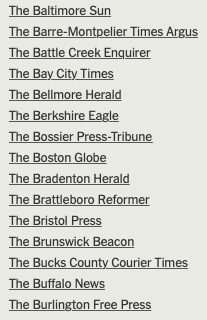Branded content comes in many forms, as our kissin’ cousins at Sneak Attack have extensively chronicled. The New York Times has been particularly adroit at all forms of branded content, which Sneak Adtack noted earlier this year.
For the past four years the hardtracking staff has chronicled the drift by the New York Times toward cross-platform integration of native advertising, a.k.a. Russian Nesting Ads. A company runs an ad in the paper’s print edition that promotes an online ad that the Times’s T Brand Studio has created to look like editorial content. (Representative sample here.)
The Boston Globe, on the other hand, has only flirted with native advertising up to now, as in this bit of UMass marketing from a few years ago. Given the evidence of the past week, though, the $tately local broadsheet seems ready to dive into the deep end of the stealth marketing pool.
Last week’s Boston Sunday Globe included this eight-page Advertising Supplement produced by Boston Globe Media’s BG BrandLab.

With branded content, the first thing you want to look at is disclosure – how clear is it to readers that they’re looking at marketing material and not editorial content?
Give this effort a C- in transparency. “Special Report” is about three times the type size of “Advertising Supplement” on the front page, and this sort-of masthead – buried bottom left – occupies about five percent of page two.

Inside there are six unbylined articles along with four “Provided by” items that are presumably paid content.

Not surprisingly, the advertising supplement’s “Knowledge Partners” at the bottom of Page One also occupied some of the inside space, starting with this American Cancer Society advertorial atop page two.

Then the Boston Breast Cancer Equity Coalition got its ad turn.

And, of course, Susan G. Komen New England also made an advertising appearance.

There were also traditional ads for Lady Grace, Avon, and the Dana-Farber Cancer Institute.
Then yesterday came this Special Report on cybersecurity.

In terms of transparency, this one gets a D. Start with the top of page two, which looks very much like a standard Editor’s Letter.

(Note to BGniks: You might want to standardize the spelling of your name. The front page has BG BrandLab, the foreword is by BG Brandlab, and the sign-off is The BG Brand Labs Team. Details, people.)
The sort-of masthead that was small in the first insert is positively minuscule in this one.

See that tiny band at the bottom? That’s it.
Other differences: There are a couple of bylined articles; “Provided by” has mostly turned into “Sponsored by” (one of them is on election security from Brianna Wu, although it does not identify her as a primary challenger to Stephen Lynch in Massachusetts’ 8th district – bad investment); and the Knowledge Partners on the front page – the National Cyber Security Alliance and Mitre – don’t have ads inside.
Oh, yes – and the whole thing looks a lot more like an editorial section than the first one.
But at least those two inserts are marginally transparent about being marketing material. Far worse was last month’s Globe wet kiss to Boston Children’s Hospital in the form of A 150th Anniversary Special Issue. It’s just the latest instance of the Globe’s playing footsie with BCH over the past few years, although it’s an especially egregious one in that it required the participation of the Globe newsroom.
It’s one puff piece after another, interspersed with dozens of costly congratulatory ads.
But no mention in those 68 pages of the hospital’s wanton destruction of the beloved Prouty Garden, or the battle over the hospital’s questionable expansion to service a projected – but by no means assured – international clientele.
To recap:
The BG BrandLab inserts strike us as Misdemeanor Misleading. The BCH 150th anniversary issue was Felony Failure of editorial integrity.
Court is adjourned.





 Posted by Campaign Outsider
Posted by Campaign Outsider 



























